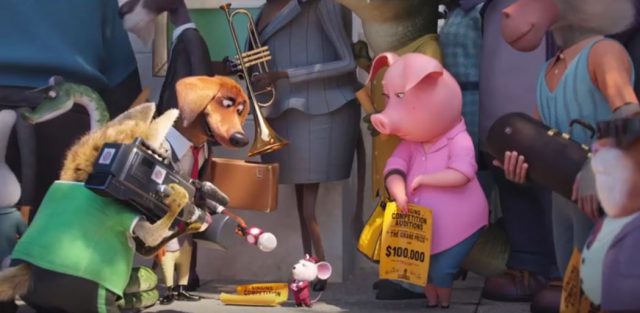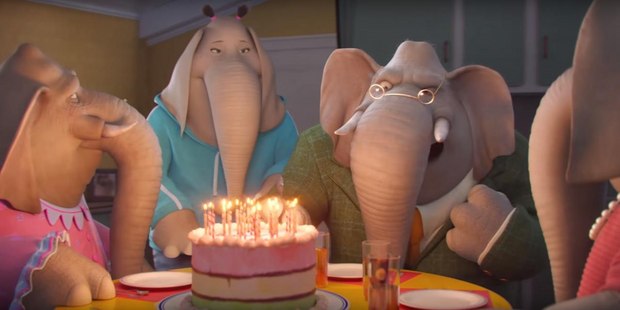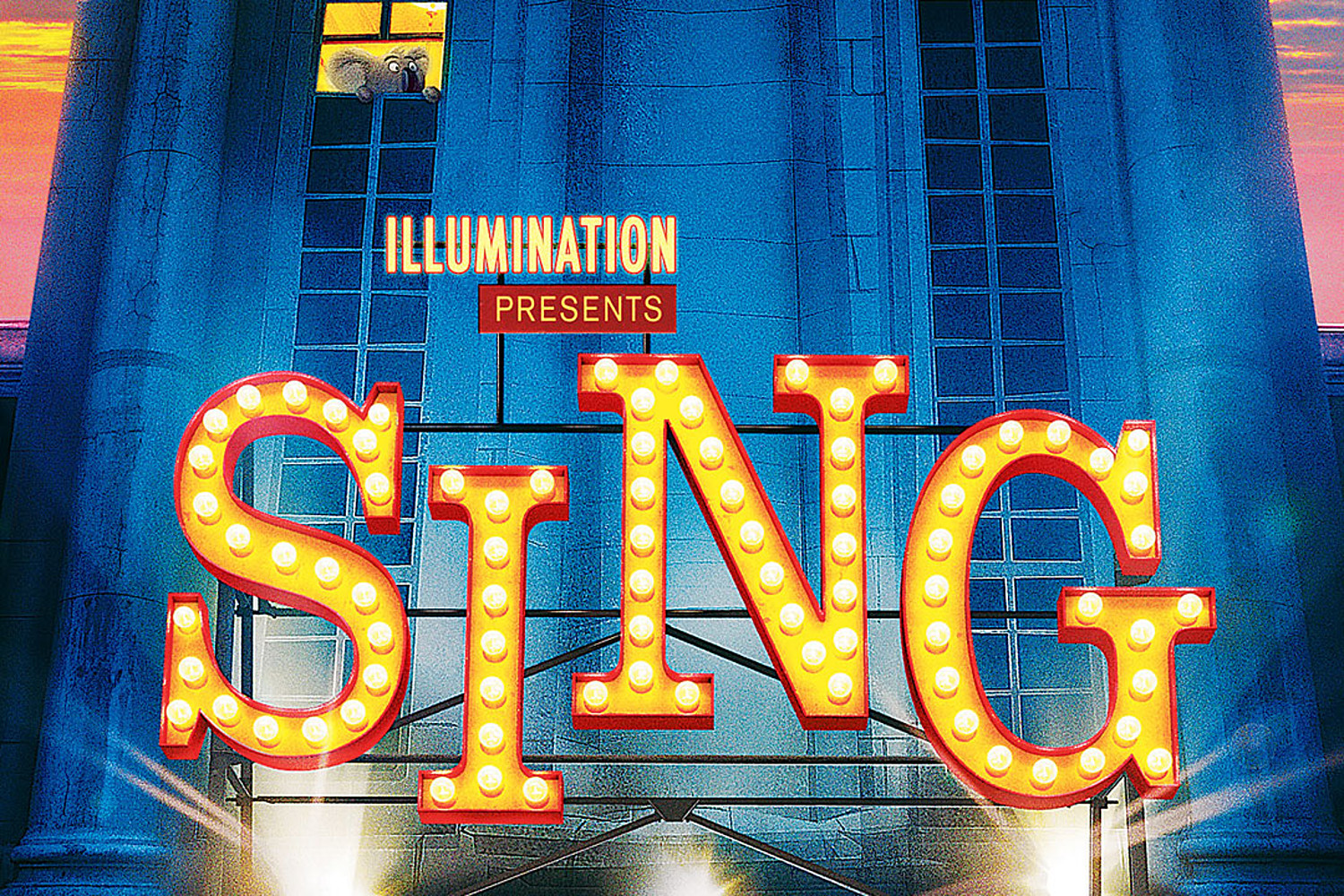Illumination Entertainment is still trailing the frequent quality of Disney, Pixar and Dreamworks Animation, but it’s nonetheless managed some truly titanic commercial hits. The studio’s earlier 2016 release, The Secret Life of Pets, defied a fairly unoriginal storyline to nonetheless become a huge box office earner, and for the first time, that movie is being followed up by another Illumination project in the same year! Rounding off December 2016’s movie releases is Sing, a movie with no shortage of charm and beauty, even if it still feels derivative and significantly less memorable than most of the other animated movies that came out in 2016.
After some deliberation, I think I’ve nailed down the interesting predicament of Illumination Entertainment, whether or not it’s of high concern to the studio. You see, Illumination is very good at character design, hence why they’ve never had trouble coaxing families and general moviegoers to see all of their movies in theatres, and why they’ve made one of the single most massive marketing forces of the 21st Century at this point in Despicable Me’s ever-iconic Minions. Despite their outstanding skills at designing personalities however, the studio has trouble with truly noteworthy plotlines, which is why their movies are often commercially successful, but tend to struggle with lasting value.

Sing continues to embody this persistent formula for Illumination. The characters in the movie are really great, with standout performances throughout that make them incredibly easy to root for, and very memorable for the most part. The storyline however has been done in hundreds of other movies, animated or otherwise, and that makes it difficult to get all that excited about. Sing nonetheless remains one of Illumination’s better movies for sure, having humour and heart to spare, along with a tried-and-true theme of believing in yourself and your talents. It’s still not enough to truly send this animation studio to the big leagues though.
Sing has a huge ensemble cast of anthropomorphic animals headlining it, though it’s all brought together by enterprising koala bear, Buster Moon, voiced by Matthew McConaughey. Buster poured his entire life savings into running a stage theater, but his shows have failed to catch on with audiences. Now facing bankruptcy, Buster decides to put on a singing competition as a last-ditch effort to stay afloat, and that’s where the other characters come in.
The usual parade of archetypes start flowing in from here. You’ve got your under-appreciated single mom in pig matriarch, Rosita, voiced by Reese Witherspoon, your downtrodden son who is trying to reject the dubious family business in gorilla bank robber, Johnny, voiced by Taron Egerton, your neglected adolescent girlfriend in wannabe porcupine, Ash, voiced by Scarlett Johansson, your meek and super-shy elephant girl named Meena, voiced by Tori Kelly, and your talented, but arrogant struggling musician in shifty mouse, Mike, voiced by Seth MacFarlane. If you think you already know how every single one of these character arcs is going to unfold, you’re probably right as well. Sing actively seems to take pride in its complete lack of character curveballs, providing reliable, if outwardly uninteresting animated comfort food that will see these personalities to their inevitable future success, even when it looks like there’s immovable obstacles being thrown in their path.

The same is true of Buster, who is at least made more interesting by virtue of some of the eccentric characters he’s forced to seek help from to keep his show running. John C. Reilly is a performance standout as Buster’s shiftless rich friend, Eddie Noodleman, as is Jennifer Saunders as Eddie’s grandmother, Nana Noodleman, a very famous singer. The movie’s writer/director, Garth Jennings also contributes some of the best jokes in the movie as Buster’s oblivious elderly iguana assistant, Ms. Crawly. Clearly, there’s no shortage of personality in Sing, which is pretty easy to laugh and smile along with. That said though, there isn’t much to read into either. Everyone is fun, while being perfectly adequate in terms of expected character depth, and not really breaking any new ground for animated movies in particular. I suppose that’s fair, even if it’s not that interesting in the long term.
Like I said, Sing seems to take pride in how averse it is to actually avoiding true story twists. The movie hits literally every note that you would expect it to, for better or for worse. The story is certainly comforting in that respect, though barring one or two decent surprises, you’ll know exactly how it’s all bound to end right from the opening minutes. Sing telegraphs all of its major story turns well in advance, so kids in particular will never have to be seriously challenged in thinking that anything is ever seriously wrong with the characters or their lives.

Still, Sing certainly gets points for being likable, and I suppose that there’s something to be said about the virtue of doing the simple stuff well, rather than the complex stuff poorly. The movie knows what it is, and maybe that is at least somewhat praiseworthy, even if the storytelling does ultimately leave a bit to be desired. It’s too bad that Sing proudly forsakes opportunities to be smarter or more challenging, but I suppose it still succeeds as a crowd-pleaser. As long as you’re not expecting many twists out of the story, that certainly works.
Illumination seems to be at least somewhat aware of the fact that Despicable Me is their only truly standout film franchise so far, since they’ve hired The Hitchhiker’s Guide to the Galaxy’s Garth Jennings to direct Sing, alongside directing newcomer, Christophe Lourdelet, who previously did animation work for both Illumination and Sony Pictures Animation. Lourdelet seems to have overseen the movie’s visual design, while Jennings handles the personality. Jennings also wrote the script, which helps to make the movie’s personality shine more reliably, even when it’s unfolding exactly by-the-book.

Of course, the animation direction in Sing is also a highlight, to compensate. The movie is naturally directed in the style of a musical, and it has that same sense of showmanship and flash factor that makes it consistently easy and enjoyable to watch, when lesser direction would have made this movie much more un-engaging. A pessimist could say that this kind of direction definitely amounts to Sing being style-over-substance, but it’s still definitely one of the most polished and lovable Illumination movies since the original Despicable Me, for what that’s worth.
A huge part of Sing is naturally its soundtrack, and to the movie’s credit, it does pack in a pretty good selection of licensed music. The music encompasses many different genres and eras, having some great classic favourites, even if a few more tiresome and instantly-dated contemporary pop tunes still sneak into the soundtrack every so often. The music suite definitely has more hits than misses though, and Joby Talbot, the movie’s composer, seems to have a pretty good sense of how to pick stage-friendly tunes that suit a movie like this. Talbot not really being a film composer at heart, and having the bulk of his experience in a capella composition, seems to work in Sing’s favour as well, adding a sense of authenticity to the songs that helps to immerse audiences, even in a movie set in a world of talking humanoid animals.

The rest of the audio work also carries a pretty good sense of style, while remembering to inject a sense of cartoon charm when necessary. There are quite a few frenetic, chaotic-sounding scenes throughout Sing, with the audio definitely doing what it can to crank up the energy in hopes of holding the attention of children in particular. The movie never comes off as unnecessarily wired though, having the right amount of energetic showmanship, without overdoing it on the vigor. In a movie of this nature, a hefty amount of audio polish is definitely paramount, but fortunately, Sing effortlessly creates an experience that is consistently pleasing to the ears.
Despite whatever storytelling shortcomings Illumination continues to struggle with, there’s no question that this studio has plenty of skilled animators on its payroll. Sing is easily one of the studio’s best-looking productions to date, with highly-detailed character designs that exude personality very effortlessly. Even beyond the characters, the settings and other such backdrop have a ridiculous amount of detail and authenticity to their design, to the point where it virtually does give studios like Pixar and Dreamworks Animation a run for their money! The musical numbers are often where Sing is at its visual best as well, with the movie unfolding much like a stage performance in its own right, even considering that it’s being seen in a theatre, or perhaps on a home device later on.

Naturally, the 3D presentation of Sing is also pretty great, and lends a lot of fun and atmosphere to the more frenetic scenes and musical numbers especially. The 3D is a bit more subdued in contrast to most other Illumination movies that have come before, but it’s still quite good overall in Sing, and helps to make the movie even more engaging and immersive. This is clearly a movie meant to be viewed in 3D, so that’s definitely the ideal way to watch it. You’re still getting a well-animated and polished experience if you just watch Sing flat in 2D, but as with the majority of animated movies, you’ll get a bit more entertainment out of the experience if you pony up the few extra dollars for some 3D glasses.
You get exactly what you would expect out of Sing, for better or for worse. In a December that was full of disappointing movies though, maybe Sing giving the exact experience it advertises is perfectly acceptable. It has to be stressed however that Sing really doesn’t aim very high with its storytelling, and is giving you the exact same ‘follow your dreams’ anthem that numerous other movies over numerous decades have already done to death. If that’s alright with you though, then Sing is a polished, charming movie that is worth the price of admission, for kids and adults alike.

Some things are cliches because they work, and Sing seems to be proof of that. Illumination is still clearly a B-list animated studio, but Sing is nonetheless one of their most appealing productions, if for no other reason than how pretty and likable it is. If you don’t mind the experience being a bit disposable, and are just looking to tap and hum along with an infectiously lovable musical comedy during these dreary January months, then Sing isn’t a bad distraction for the nearly two hours or so that it spans. It’s easy to wish that the movie would have taken more risks in the end, but even if it sticks very closely to an established playbook, Sing still manages to get most of its simple ambitions right.

